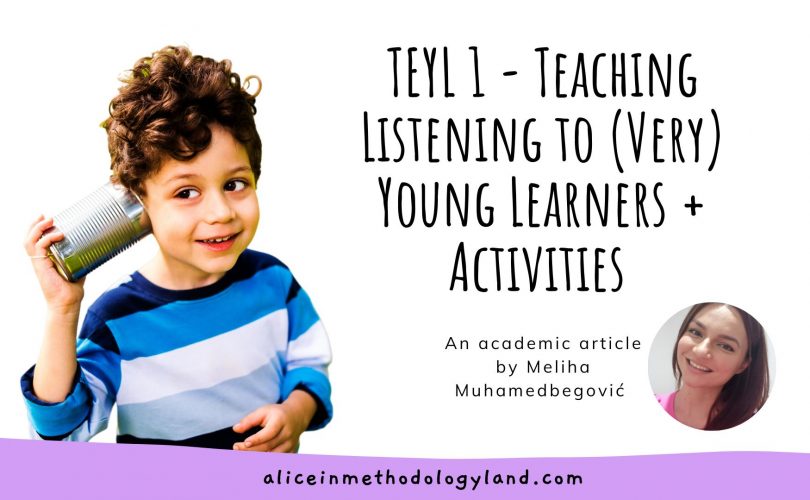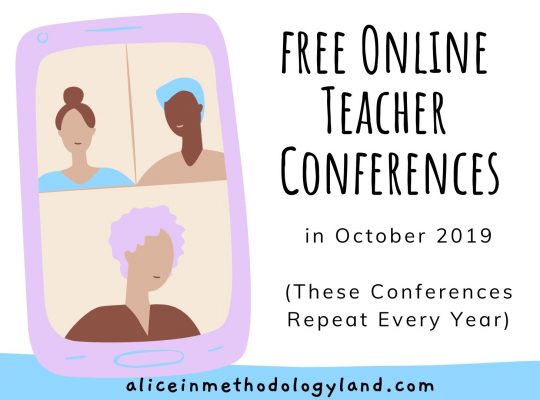Hello, my dear colleagues! We have the honor to present a new series of academic articles that will explore teaching language skills to VYLs from the theoretical perspective, while also giving practical examples at the end of each article. We hope you will enjoy Meliha’s articles.
Let’s start with TEYL: Teaching listening skills
There are many fun ways to develop listening skills and in this first part of the TEYL 101 article series, where you will learn what is listening and how to teach listening, as well as some practical activities that might be useful in your teaching. Let’s start by explaining the term young learners and their characteristics.
What are (very) young learners and what are their learning characteristics?
The term young learner (YL), frequently interpreted in different ways, refers to children from the ages of four to twelve (Eliss G, (2014, p.75), or language learners in preschool through secondary school ((Linse: 2006, p.2), while the Very Young Learners (VYL) are defined as under seven years of age (Slatterly & Willis, 2001). (V)YLs differ from older ones in language learning because they are still developing, especially their ways of thinking and attitude, learning a language, among others.
(V)YLs tend to be…
Brumfit (1997) and Clark (1990: 6-8) both agree that (V)YLs tend to be keen and enthusiastic learners but also very egocentric, as they tend to revolve around themselves. With this in mind, one can conclude that the most important characteristics of (V)YLs are:
- easily distracted and have very short attention spans (5–15 minute activities are best to engage them in learning),
- very active (seem to always be on the move),
- respond well to praise and/or reward (boosts their confidence and can inspire them to be more cooperative, persistent, and hard-working),
- less shy than older learners (tend to speak even when not being asked or about some topic not related to the lesson),
- enjoy learning through playing (play is the primary vehicle for learning) and
- imaginative (may have difficulties distinguishing between imagination and the real world).
What are the basic listening steps?
Listening, as a receptive skill, is the ability through which learners acquire knowledge and information by being exposed to listening tape or being involved in a conversation in their everyday life. (Thomlison (1984) and Hamouda (2013)). According to Brown and Yule (1983) and Hamouda (2013), listening comprehension is an individual understanding of what s/he has heard, and the listener can repeat the text despite the fact that the listener may repeat the sound without real comprehension. So if you want to teach listening, you can use a framework PWP (pre, while, post) or PDP (pre, during, post).
P/pre or warm-up phase
P/pre or warm-up phase is the first phase in which you can carry out some fun activities to prepare learners for the lesson, such as activating schema, assessing students’ background knowledge, pre-learning the new and necessary vocabulary to understand the text, and generating students’ interest in the topic.
W (while)/D (during) phase, which lasts approximately 4-10 minutes, depends on which process or method you will be following:
– top-down process (start from the background knowledge of the learners, by asking them various questions about the topic of the listening tape) or
-bottom-up process (start from the tape by explaining the words and asking the learners to listen to the first and/or the last sentence and give their predictions about what the audio is about)(Van Duzer, 1997; Nunan, 1997; Norris, 1994).
Three subcategories of W (while)/D (during) phase
In this part, W (while)/D (during), there are three main subcategories:
- listening for shallow understanding (e.g., listening for gist to get the main idea, such as T/F answers, what the audio is about, or perhaps to choose the best title),
- listening for deep understanding (to get a better understanding of the audio, mainly use wh-questions) and
- listening for deeper understanding (focus is on what is being said and trying to completely understand, for example, fill in the blanks/charts).
Post-listening phase
The last step is P, the post-listening phase, or so-called production stage, in which students/learners should produce something, such as a summary, role plays, paragraph writing, etc. Of course, the POST stage is not necessary but rather an extra stage to engage students even more by allowing them to use what they know and/or have learned creatively.
Why is listening important for (very) young learners?
There are many reasons why listening is important, but Linse (2005) stated that the teaching of listening skills should be seen as foundational to the development of other language skills, as it helps them to be successful in speaking, socializing, and communicating with others. As listening is not a passive process, a listening activity must be well-guided with clear aims (Ur, 1996). This will guide students to know where to focus, enabling them to achieve success (Funk and Funk 1989).
Classroom techniques and activities
It is claimed that in current ELT practice, listening skills are more often tested or practiced than taught (Field, 2008). Because of that reason, we teachers use various types of listening for different reasons, mainly discriminative (to distinguish sounds and develop sensitivity to nonverbal communication), aesthetic (listening for enjoyment), and efferent (listening to learn information) listening.
Having outlined (V)YLs, here are five classroom ideas that your learners will love. These games will help them to improve their listening skills and, most importantly, require few to no materials and are most effective when played in a group. Below are a few listening activities and games that target the listening components mentioned above.
Listen & play (discriminative listening)
Early music exposure helps (V)YLs predict elements and are mostly reassured by the game’s repetitive patterns (singing, shaking, guessing, counting, etc.).
Face-to-face: If you would like to try Magical Sound Box, simply put different objects, noisy ones are the best option, such as keys, a bottle, a plastic bag, a brush, a dog toy, bells – and anything else like that, into a box and then ask your students/learners to guess the object by the sound it makes.
Online: Another alternative to this game is to use an online sound box, e.g Sago Mini School and then students have to listen to the sound and guess it. You can of course modify this game as much as you want, but I also like to ask follow-up questions, such as color, size, numbers, etc.
Remember that with (V)YLs you need to introduce them to different objects and sounds before playing the game.
Listen & make (aesthetic listening)
Following directions and drawing activity ideas will teach students/learners to listen carefully and interpret instructions. It is easy to play and requires no advanced preparation. The Draw My Picture Game involves one person giving verbal directions about a picture to another.
I use this activity mainly to learn shapes and colors, numbers, and body parts, in the so-called version of my monster.
Face-to-face: The person with the picture must give instructions to their partner so they can draw it, but must not say what it is, e.g., ‘draw a circle, draw two noses, draw a big head. The person in the picture cannot watch the person that is drawing because they will compare the drawing with the original. You can hand out more pictures or if they know to read, very simply written instructions to read and ask participants to swap roles.
Online: Another wonderful opportunity to create and explore their creativity is to use free drawing tools, such as Quick, Draw!, or Tate Paint, where kids will draw cute characters in a fun and playful manner.
I am really fond of this activity as students have and are exposed to different accents and pronunciations.
Listen & respond (critical listening)
In this activity, students can play in teams or individually. It requires listening to the previous person’s words and then coming up with a word that starts with the letter they ended on. Horse….Ear…Right….Tiger…. It is a great resource for revision and for practicing the alphabet. For VYLs, I suggest writing the word on the whiteboard so that they can see the last letter, and for YLs, since my kids are game addicted and know more words than is suitable to their level, I make it more complex by limiting the categories, like only naming animals, body parts, etc.
Listen, guess, and tell (efferent listening)
A simple follow-up activity, for example, Guess Who? or Guess What? is a hiding game, where one learner at a time describes a person from class/school, while other learners try to guess who they are or to match them correctly.
You can find many online games on plays.org, and they are spam free (no ads).
To conclude
So there you have it – some of our favorite listening games for face-to-face and online teaching, which children will love. Remember that the suggestions listed above are just the beginning. Give them a go, and if you’ve found this useful, please let us know your favorite way to practice listening via the contact page or in the comments.
Meliha Muhamedbegović received her Bachelor of Arts (B.A) in English Language and Literature with a focus on ESL/EFL teaching from Tuzla University in 2014. She continued her education and pursued a Master’s Degree in English Linguistics from the same University, graduating in 2017. She also earned a CAE certificate from British Council in 2016.
She is also running her own TpT store, where she interacts with other teachers and/or collaborates on projects and shares writing ideas. Her articles have appeared in a number of web sites, including STUDOMAT (BiH), but she also contributes articles about ESL/EFL to EFL Magazine (Japan), ELTA (Serbia), etc.
You can contact Meliha via her email [email protected] or via her LinkedIn profile.

References
- Brown, G., & Yule, G. (1983). Teaching the Spoken Language. Cambridge: Cambridge University Press.
- Brumfit (1997) Young Learners Characteristics (TEYL/TMYL). (online)
- Linse, C.T. Practical English Language Teaching: Young Learners, (2006), New York, NY: McGraw-Hill
- Clark, J (1990) Teaching children: is it different?
- Ellis, G. (2014). ‘Young learners’: clarifying our terms. ELT journal, 68(1), 75-78.
- Field, J (2008) Listening in the Language Classroom, Cambridge: Cambridge University Press
- Funk, H., & Funk, G. (1989). Guidelines for Developing Listening Skills. The Reading
- Funk, H., & Funk, G. (1989). Guidelines for Developing Listening Skills. The Reading Teacher, 42(9), 660-663.
- Hamouda, A. (2013). An Investigation of Listening Comprehension Problems Encountered by Saudi Students in the EL Listening Classroom. International Journal of Academic Research in Progressive Education and Development. 2(2), 113-155.
- Linse, C. (2005). Practical English Language Teaching: Young Learners. New York: McGraw- Hill.
- Norris, Robert W. 1994. Keeping up with Native Speaker Speed: An Investigation of Reduced Forms and Deletions in Informal Spoken English. Studies in Comparative Culture, (25) : 72-79.
- Nunan, David. 1997. Listening in Language Learning. The Language Teacher Online, 21(9).
- Slattery, M. & Willis, J. (2001). English for Primary Teachers. Oxford: Oxford
- Slattery, M. & Willis, J. (2001). English for Primary Teachers. Oxford: Oxford
- Slattery, M. & Willis, J. (2001). English for Primary Teachers. Oxford: Oxford
- Slattery, M. & Willis, J. (2001). English for Primary Teachers. Oxford: Oxford
- Slattery, M. & Willis, J. (2001). English for Primary Teachers. Oxford: Oxford University Press.
- Thomlison, T.Dean. “Relational Listening: Theoretical and Practical Considerations.” Paper presented at the Annual Meeting of the 5th International Listening Association, 1984.
- University Press.
- University Press.
- University Press.
- Ur, P. (1996) A course in Language Teaching: Practice and Theory. Cambridge University Press, Cambridge.
- Van Duzer, Carol. 1997. Improving ESL Learners’ Listening Skills: At the Workplace and Beyond. Washington D.C.: National Clearinghouse for ESL Literacy Education.








[…] TEYL 1 – Teaching Listening to (Very) Young Learners + Activities by Muhamedbegović Meliha […]
[…] TEYL 1 – Teaching Listening to (Very) Young Learners + Activities by Muhamedbegović Meliha […]